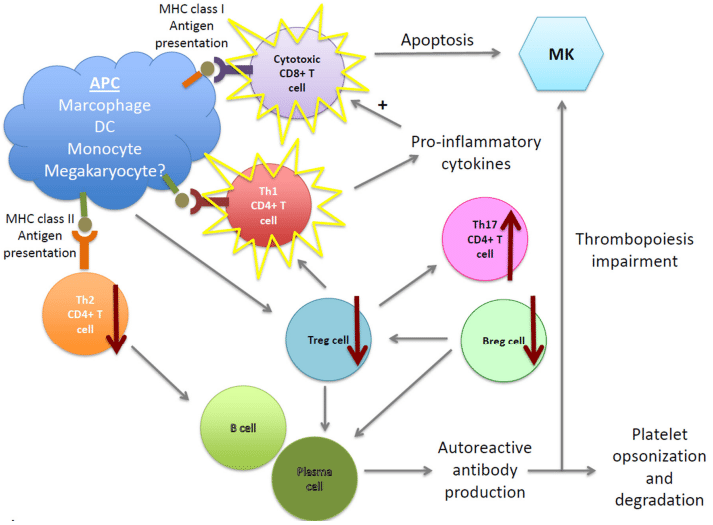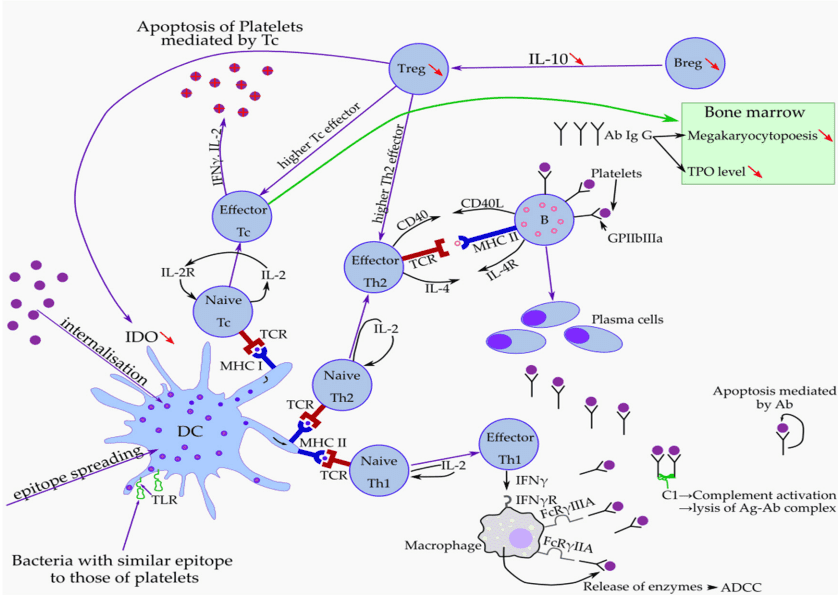NAA Associated Immune Thrombocytopenic Purpura (ITP)
Immune thrombocytopenic purpura (ITP) is shown to be associated with the appearance of natural autoantibodies (NAA). Creative Biolabs is glad to provide NAA detection and analysis services for our clients all over the world. With the consistent growth of various immune diseases (such as ITP) in the world, it is important to improve the accuracy of clinical diagnosis with suitable methods. As stability is one of the most important requirements for the application of therapeutic and diagnostic antibodies, Creative Biolabs has developed a remarkable platform for NAA services to promote your drug design and development projects.
Introduction of Immune Thrombocytopenic Purpura (ITP)
ITP is a kind of thrombocytopenic purpura disease that is defined because of the isolated low platelet count (thrombocytopenia). The patients have normal bone marrow but lack the platelet count. It leads to a characteristic purpuric rash and an increased tendency to bleed. The clinical syndromes are distinct and manifest due to an acute or a chronic condition, respectively. The acute form often induces an infection and has a spontaneous resolution within two months. Chronic immune thrombocytopenia persists longer than six months and the specific cause is also unknown.
ITP is an autoimmune disease along with numerous autoantibodies against several platelet surface antigens. The diagnosis of ITP usually presents a low platelet count in a complete blood count (a common blood test). However, since the diagnosis depends on the exclusion of other factors causing low platelet count, some additional detections (such as a bone marrow biopsy) are required in some cases.
 Fig.1 Cellular pathogenic mechanisms in ITP.1
Fig.1 Cellular pathogenic mechanisms in ITP.1
Treatment of ITP
In the cases with low platelet count or significant bleeding, the prompt treatment is to inject with corticosteroids, intravenous immunoglobulin, anti-D immunoglobulin, or immunosuppressive medications. Refractory ITP (tolerant to conventional treatment) may require a splenectomy to remove the spleen. Platelet transfusions can be used in severe bleeding and very low platelet cases.
Signs and Symptoms of ITP
The signs and symptoms of ITP include the spontaneous formation of bruises (purpura) and petechiae (tiny bruises), bleeding from the nostrils and/or gums, and menorrhagia (excessive menstrual bleeding) when the platelet count is below 20,000 per μl. The hematomas (blood masses) in the mouth or on other mucous membranes may appear when the count is low to 10,000 per μl. Serious and even fatal complications include subarachnoid or intracerebral hemorrhage (bleeding inside the skull or brain), lower gastrointestinal bleeding or other internal bleeding because of extremely low counts (<5,000 per μL).
In about 60% of cases, autoantibodies against platelets can be detected. Most of these autoantibodies (IgG type) are against platelet membrane glycoproteins IIb-IIIa or Ib-IX. When the platelets are coated with IgG, they become susceptible to opsonization and phagocytosis by splenic macrophages, as well by Kupffer cells in the liver. The IgG autoantibodies are also believed to damage megakaryocytes. Previous research indicated that impaired production of the glycoprotein hormone thrombopoietin, which is the stimulant for platelet production, maybe a reason for the reduction in circulating platelets. Therefore, the research findings have led to the development of a class of ITP-targeted medications referred to as thrombopoietin receptor agonists.
 Fig.2 The influence of autoantibodies (Ab) on thrombocytopenia and hemorrhagic events in ITP.2
Fig.2 The influence of autoantibodies (Ab) on thrombocytopenia and hemorrhagic events in ITP.2
Common NAA Targets Associated with ITP
The production of IgG NAA is the cause of the ITP, therefore, the detection and analysis of NAA can be as an indication to support the diagnosis of ITP. Nowadays, there are five biomarkers have been recognized in the ITP disease, which may be potential targets for anti-ITP drug discovery:
| Natural Autoantibodies Targets in Human ITP | ||||
| Anti-Platelet | Anti-Cardiolipin | Anti-Lupus Anticoagulants (LA) | Anti-Phospholipid | Anti-β2 Glycoprotein 1 |
Associated NAA Detection in ITP
In most of the ITP cases, NAA can be detected with different levels. The majority of these autoantibodies are IgG, but IgM and IgA can also be identified in some patients with ITP. Those NAA play an important role in immune regulation, in addition, natural IgG antibodies affect the numbers of pre-B and B cells in bone marrow, IgM-NAA and IgM anti-leukocyte antibodies (IgM-ALA) inhibit autoimmune inflammation through anti-idiotypic mechanisms and regulate the function of dendritic cells (DC) and other effector cells. Because NAA greatly contributes to many immune diseases, they are essential in medicine development and diseases diagnosis as well as appropriate therapeutic intervention in autoimmune and malignant diseases.
Features
- Comprehensive antibody discovery and modification services
- Target-specific detection and analysis services
- Theranostics platform for simultaneous diagnosis and therapy
- Rapid, cost-effective and highly reliable services
Creative Biolabs is dedicated to offering NAA services to help you detect new NAA biomarkers or analyze the present NAA targets associated with ITP. Our customized detection and profiling methods include western blotting, ELISA and high-throughput methods, etc. Our high-quality products and services will contribute greatly to the success of your projects with timely and cost-effective manner. Please feel free to contact us for more information and a detailed quote.
References
- Zufferey, Anne, Rick Kapur, and John W. Semple. "Pathogenesis and therapeutic mechanisms in immune thrombocytopenia (ITP)." Journal of clinical medicine 6.2 (2017): 16.
- Tărniceriu, Claudia Cristina, et al. "Immune Thrombocytopenic Purpura as a Hemorrhagic Versus Thrombotic Disease: An Updated Insight into Pathophysiological Mechanisms." Medicina 58.2 (2022): 211.
Choosing natural autoantibody (NAA) microarray to profile autoantibody repertoire and reveal novel disease's marker.

